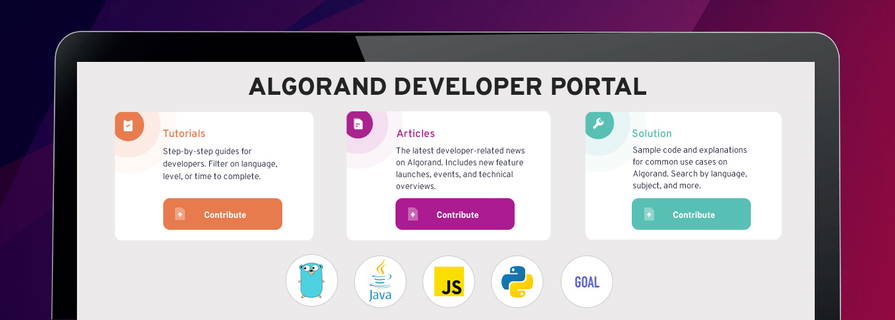note
Showing 302 posts related with note.
-
 Intermediate · 1 hour
Intermediate · 1 hourDecentralised co-operative unions with Algorand Multisignature Account
Blockchain credit union membership contributions and payments on Algorand.
-
 Beginner · 30 minutes
Beginner · 30 minutesCreate and Manage a Non-Fungible ASA from the Command Line Using goal
This tutorial guides you step-by-step through the creation and configuration of a non-fungible Algorand Standard Asset (ASA) from the command line using goal.
-
 Intermediate · 30 minutes
Intermediate · 30 minutesLimitOrder Contract with Python
A walkthrough example of how to use a limit order contract with Python.
-
 Intermediate · 1 hour
Intermediate · 1 hourParticipate in Consensus from Ledger Nano S/X
In this tutorial, we show how to participate in consensus from an account stored in a Ledger Nano S or X. By participating in consensus, you help decentralize the network.
-
 Beginner · 15 minutes or less
Beginner · 15 minutes or lessAccess BetaNet Network using your own node and goal
This tutorial describes how to setup and update a BetaNet network using your own node and goal.
-
 Intermediate · 1 hour
Intermediate · 1 hourIntegrating ALGO and ASA transfers within your application
Learn how to integrate your application with Algo or ASA by walking through code examples.
-
 Intermediate · 1 hour
Intermediate · 1 hourSending Rewards to ICO Investors Using Batch Transactions in Python
In the early stages of their project, ASA creators are supported by the contributions of early investors. In this tutorial, we will look at how you can obtain all the transactions that have been made to your wallet and reward donors with your token.
-

Use Quick-Algo to Start Running an Algorand Node in Under 1 Minute
Learn the basics to running an Algorand node and use the `quick-algo` shell script to get you up and running with a fully customizable Algorand node in under 1 minute.
-
 Beginner · 30 minutes
Beginner · 30 minutesCreating an Algorand Node on Microsoft Azure
In this tutorial we will create an Algorand node on Microsoft Azure.
-
 Beginner · 30 minutes
Beginner · 30 minutesAlgorand Studio | Tutorial 1: Basic Features
Set up your local machine for Algorand development using Algorand Studio, includes a walk through its basic features.
-

Building on Algorand: Developer Week 2020 Hackathon, Recap and Code
Over 600 attendees participated recently at the Algorand Sponsored Developer Week 2020 in San Francisco...
-

PyTeal — Writing Algorand Smart Contracts in Python
PyTeal is a python language binding for Algorand Smart Contracts (ASC) that abstracts away the complexities in writing smart contracts. PyTeal is provided as an open-source tool for the Algorand community. We invite you to try, use, and contribute to PyTeal if you are interested in developing and deploying ASC’s in Python.
-

Welcome to the Algorand Developer Portal
The new Algorand Developer Portal provides resources for developers to turn their ideas into full-scale applications. Browse and search across new content, like Tutorials and Solutions. Access technical documentation. Stay up-to-date on the latest features.
-

Contribute to the Algorand Community and Earn Rewards
Last week we launched our new Developer Portal, with significant improvements to how developers can learn to use and implement applications on the Algorand blockchain. We are looking for developers to help us expand the content on this site, and the Algorand Foundation is rewarding those who do!
-

Getting Started on Algorand
In this article, we are going to cover some of the basics of where to start, what tutorials are available, options for setting up your development environment, and how you can be rewarded for developing applications on the Algorand blockchain.
-

Contribute to the Algorand Developer Docs
The official Algorand Developer Documentation repository is now public and open to contributions. Read the contributing guide to get started.
-

Getting Started with Assets
Creating an asset is simply a type of transaction on Algorand. There is no contract code required. Here are five ways to get started developing with Algorand Standard Assets.
-

Algorand V2 SDK Asset and Atomic Transfer Examples
New Algorand SDK V2 examples for Assets and Atomic Transfers